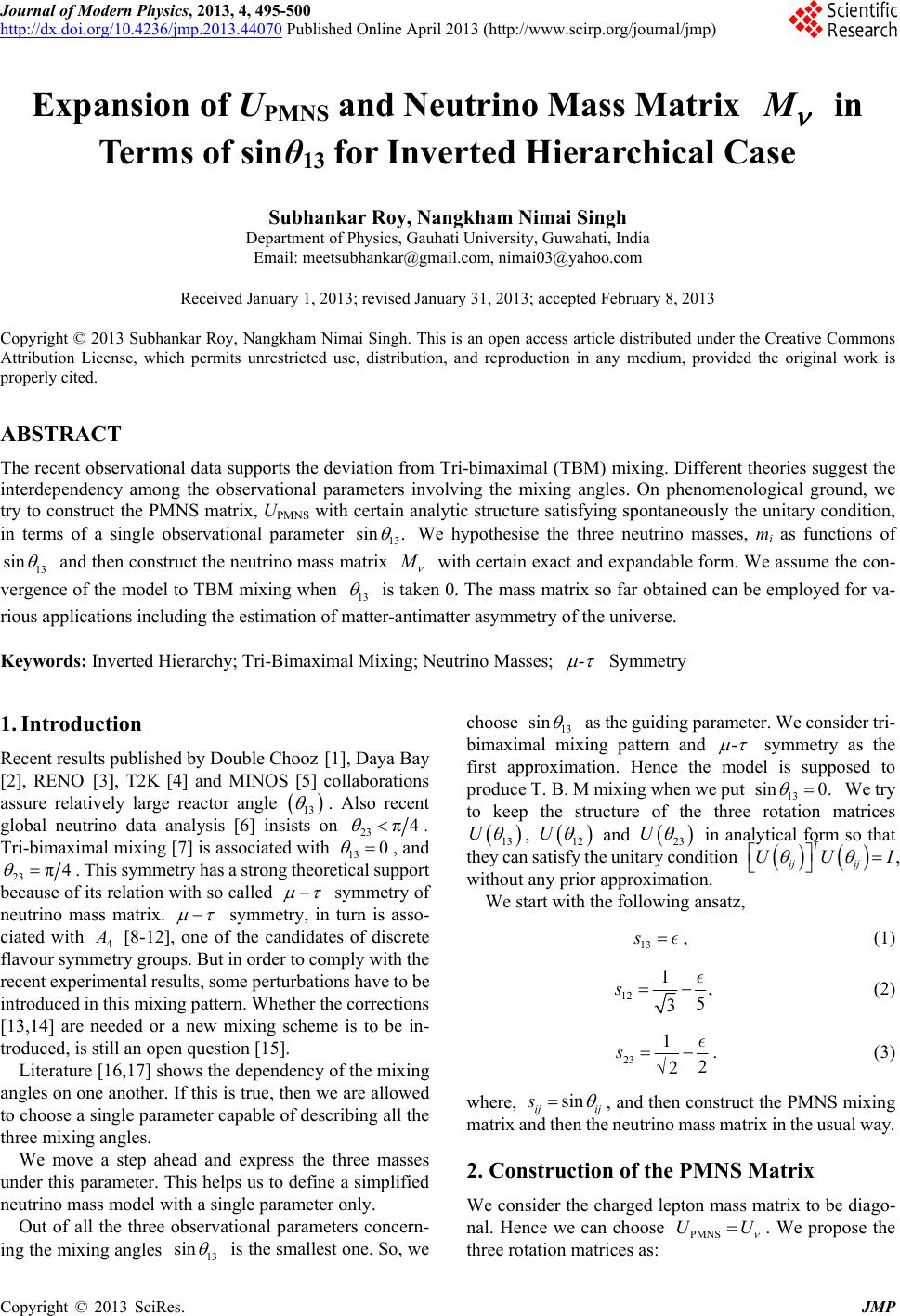 Journal of Modern Physics, 2013, 4, 495-500 http://dx.doi.org/10.4236/jmp.2013.44070 Published Online April 2013 (http://www.scirp.org/journal/jmp) M Expansion of UPMNS and Neutrino Mass Matrix in Terms of sinθ13 for Inverted Hierarchical Case Subhankar Roy, Nangkham Nimai Singh Department of Physics, Gauhati University, Guwahati, India Email: meetsubhankar@gmail.com, nimai03@yahoo.com Received January 1, 2013; revised January 31, 2013; accepted February 8, 2013 Copyright © 2013 Subhankar Roy, Nangkham Nimai Singh. This is an open access article distributed under the Creative Commons Attribution License, which permits unrestricted use, distribution, and reproduction in any medium, provided the original work is properly cited. ABSTRACT The recent observational data supports the deviation from Tri-bimaximal (TBM) mixing. Different theories suggest the interdependency among the observational parameters involving the mixing angles. On phenomenological ground, we try to construct the PMNS matrix, UPMNS with certain analytic structure satisfying spontaneously the unitary condition, in terms of a single observational parameter 13 sin . We hypothesise the three neutrino masses, mi as functions of 13 sin and then construct the neutrino mass matrix with certain exact and expandable form. We assume the con- vergence of the model to TBM mixing when 13 is taken 0. The mass matrix so far obtained can be employed for va- rious applications including the estimation of matter-antimatter asymmetry of the universe. Keywords: Inverted Hierarchy; Tri-Bimaximal Mixing; Neutrino Masses; - Symmetry 1. Introduction Recent results published by Double Chooz [1], Daya Bay [2], RENO [3], T2K [4] and MINOS [5] collaborations assure relatively large reactor angle 13 . Also recent global neutrino data analysis [6] insists on 23 π4 . Tri-bimaximal mixing [7] is associated with 13 0 , and 23 π4 . This symmetry has a strong theoretical support because of its relation with so called symmetry of neutrino mass matrix. symmetry, in turn is asso- ciated with 4 [8-12], one of the candidates of discrete flavour symmetry groups. But in order to comply with the recent experimental results, some perturbations have to be introduced in this mixing pattern. Whether the corrections [13,14] are needed or a new mixing scheme is to be in- troduced, is still an open question [15]. Literature [16,17] shows the dependency of the mixing angles on one another. If this is true, then we are allowed to choose a single parameter capable of describing all the three mixing angles. We move a step ahead and express the three masses under this parameter. This helps us to define a simplified neutrino mass model with a single parameter only. Out of all the three observational parameters concern- ing the mixing angles 13 sin is the smallest one. So, we choose 13 sin as the guiding parameter. We consider tri- bimaximal mixing pattern and - sin 0. symmetry as the first approximation. Hence the model is supposed to produce T. B. M mixing when we put 13 We try to keep the structure of the three rotation matrices U13 23 U U12 , and in analytical form so that they can satisfy the unitary condition † ij ij UU I 13 s , without any prior approximation. We start with the following ansatz, , (1) 12 1, 5 3 s (2) 23 1 2 2 s sins . (3) where, ij ij , and then construct the PMNS mixing matrix and then the neutrino mass matrix in the usual way. 2. Construction of the PMNS Matrix We consider the charged lepton mass matrix to be diago- nal. Hence we can choose PMNS UU . We propose the three rotation matrices as: C opyright © 2013 SciRes. JMP 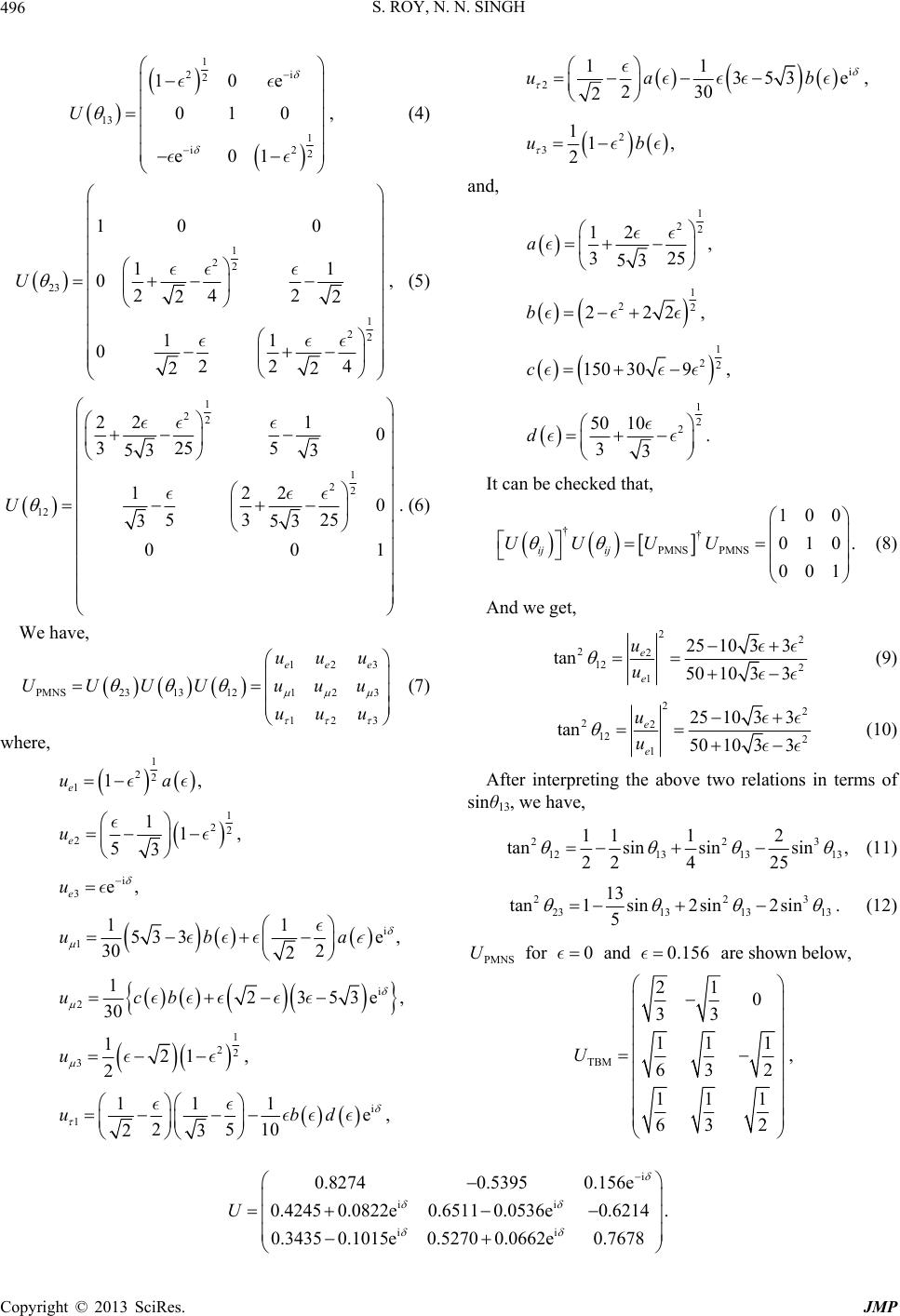 S. ROY, N. N. SINGH 496 1 2 13 10 01 e0 U 2i 1 i2 2 e 0 1 , (4) 1 22 23 10 024 11 022 U 1 22 0 11 2 22 4 22 , (5) 1 22 12 22 325 53 12 53 35 00 U 1 22 10 5 3 2 0 25 3 1 123 2 3 123 ee e uuu uuu uuu . (6) We have, PMNS 23 13 121 UU UU (7) where, 1 22 1,ua 1e 1 22 11, 3 i 3e, e u 25 e u i 11 e, 2a 153 3 30 2 ub i 2 12353e,ucb 30 1 22 3 121 2 u , i 1 111 e 2510 23 ubd , i 2 11 353 e 230 2 ua b , 2 3 11, 2 ub and, 1 22 12 , 325 53 a 1 22 222,b 1 22 150 309,c 1 2 2 50 10 33 d †† PMNS PMNS 100 010. 001 ij ij UU UU . It can be checked that, (8) And we get, 22 22 12 2 1 2510 33 tan 5010 33 e e u u (9) 22 22 12 2 1 2510 33 tan 5010 33 e e u u (10) After interpreting the above two relations in terms of sinθ13, we have, 223 1213 1313 11 12 tansinsinsin , 22 425 (11) 223 231313 13 13 tan1 sin2sin2sin 5 PMNS U0 . (12) for and 0.156 are shown below, TBM 21 0 33 11 1 63 2 11 1 63 2 U i ii ii 0.82740.5395 0.156e 0.42450.0822e0.6511 0.0536e0.6214 . 435 0.1015e0.5270 0.0662e0.7678 U , 0.3 Copyright © 2013 SciRes. JMP 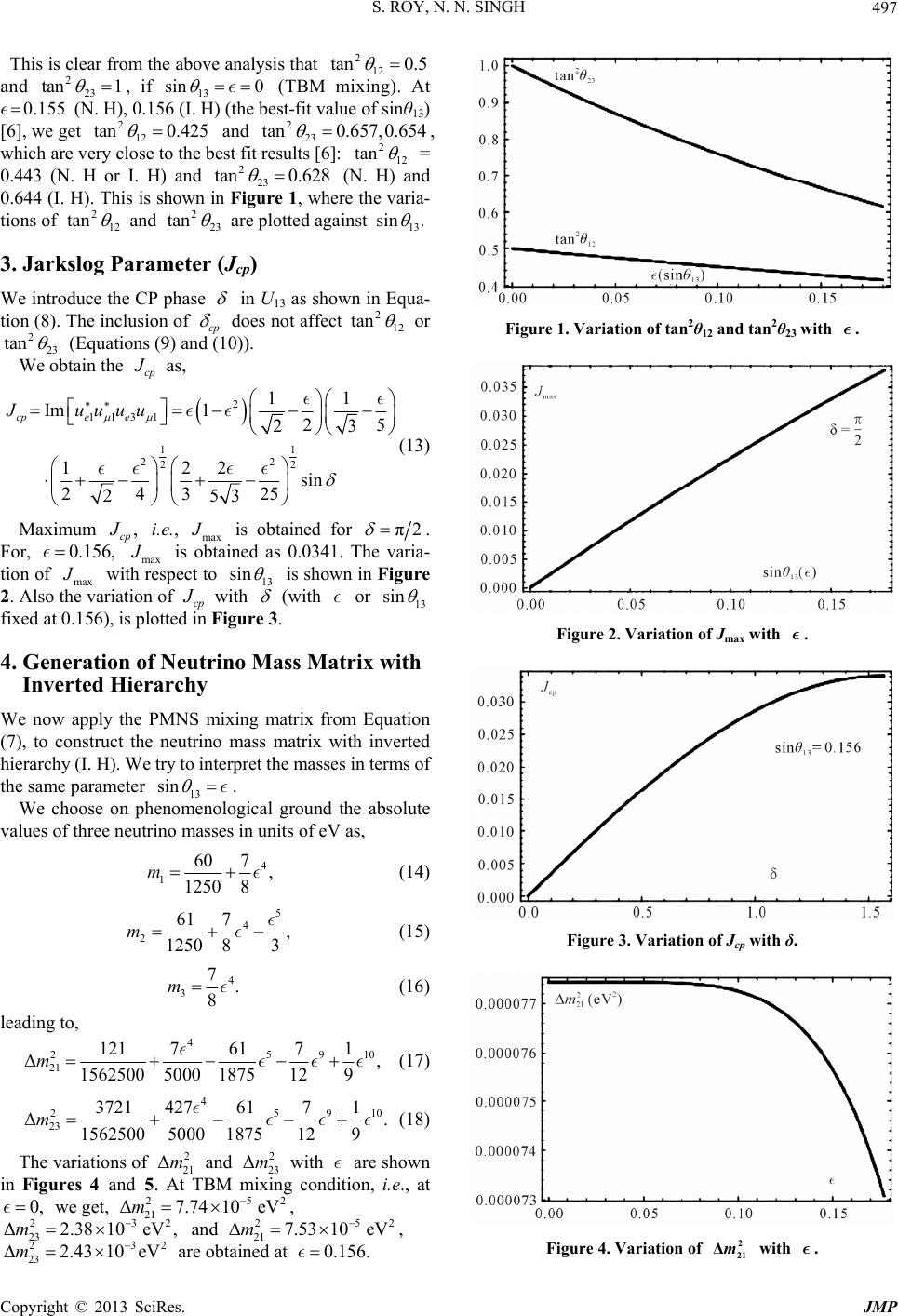 S. ROY, N. N. SINGH 497 This is clear from the above analysis that 12 and , if 13 2 tan 0.5 ta sin 2 23 n 1 0 2 23 tan (TBM mixing). At (N. H), 0.156 (I. H) (the best-fit value of sinθ13) [6], we get and , which are very close to the best fit results [6]: 12 0.1 0.657,0.654 2 tan 55 2 12 tan 0.425 = 0.443 (N. H or I. H) and (N. H) and 0.644 (I. H). This is shown in Figure 1, where the varia- 2 23 tan 0.628 tions of 2 12 tan and ta 2 23 n are plotted against 13 sin . 3. Jarkslog Parameter (Jcp) We introduce the CP phase in U13 as shown in Equa- tion (8). The inclusion of cp does not affect 2 12 tan or 2 tan 23 (Equations (9) and (10)). We obtain the as, cp J 2 1131 1 22 22 Im 1 122 243 2 253 cpe e Juuuu 1 11 25 23 sin 5 , (13) Maximum cp i.e., max J is obtained for π2 . For, max 0.156, is obtained as 0.0341. The varia- tion of max with respect to sin 13 is shown in Figure 2. Also the variation of cp with J (with or 13 sin fixed at 0.156), is plotted in Figure 3. 4. Generation of Neutrino Mass Matrix with Inverted Hierarchy We now apply the PMNS mixing matrix from Equation (7), to construct the neutrino mass matrix with inverted hierarchy (I. H). We try to interpret the masses in terms of the same parameter 13 sin . We choose on phenomenological ground the absolute values of three neutrino masses in units of eV as, 4 607 , 1250 8 1 m (14) 5 4 7, 8 3 2 61 1250 m (15) 4 3 7. 8 m (16) leading to, 4 25 21 121 761 Δ 15625005000 1875 m 910 71, 12 9 (17) 4 910 71 . 12 9 2 Δm2 m 0,2 Δ7.74 eV 2252 7.53 10eVm 0.156. 25 23 3721 42761 Δ 15625005000 1875 m (18) The variations of 21 and 23 Δ with are shown in Figures 4 and 5. At TBM mixing condition, i.e., at we get, , and 21 Δ, are obtained at 25 10 21 m 23 eV , 3 eV 23 Δ10m 23 10m 2.38 2 2.43 2 Figure 1. Variation of tan2θ12 and tan2θ23 with . Figure 2. Variation of Jmax with . Figure 3. Variation of Jcp with δ. Figure 4. Variation of with . m2 21 Δ Copyright © 2013 SciRes. JMP 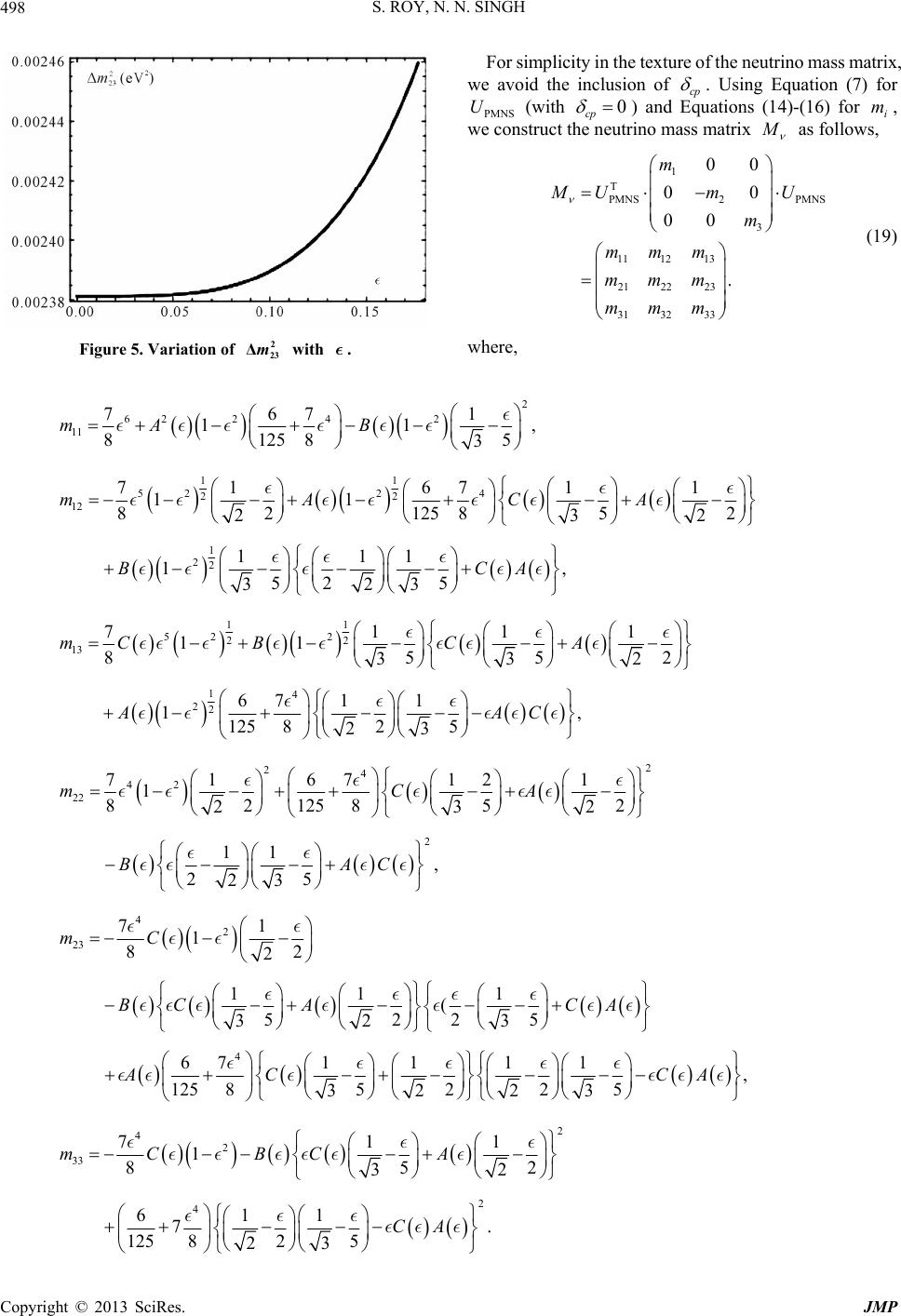 S. ROY, N. N. SINGH 498 Figure 5. Variation of with . For simplicity in the texture of the neutrino mass matrix, we avoid the inclusion of cp . Using Equation (7) for PMNS (with cp U0 ) and Equations (14)-(16) for i, we construct the neutrino mass matrix m as follows, 1 T PMNS2 PMNS 3 11 1213 21 2223 31 3233 00 00 00 . m MUm U m mmm mmm mmm (19) where, m2 23 Δ 2 62 242 11 7671 11, 81258 5 3 mAB 11 2 4 22 671 1 11 82125852 232 111 1, 525 323 mACA BCA 52 12 1 22 71 11 52 2 22 13 14 22 7111 11 8552 332 67 11 1, 5 mCBC A AAC 125 8 2 23 2 82 12585 23 11 , 25 23 BAC 2 24 42 22 7167121 12 2 mCA 4 2 23 71 1 82 2 1, 5 3 mC A CA 4 11 1 ( 5225 32 3 671 11 125 8522 322 BC AC AC 4 2 33 2 4 71 1 85 32 611 7. 125 825 23 mC BCA CA 2 1 2 Copyright © 2013 SciRes. JMP 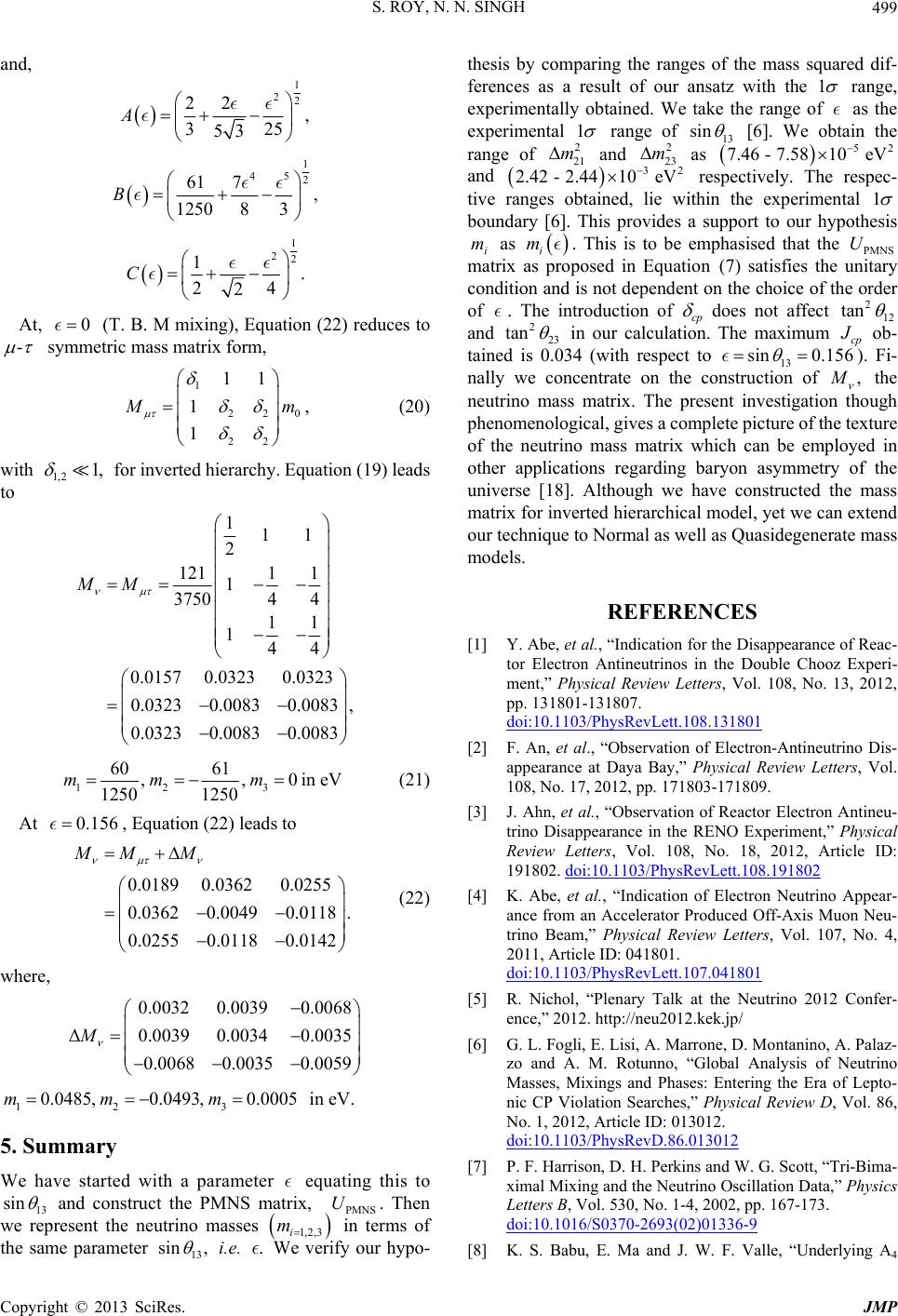 S. ROY, N. N. SINGH 499 and, 1 22 22 , 325 53 A 1 45 2 7, 8 3 61 1250 B 1 22 24 2 C 0 - 1. At, (T. B. M mixing), Equation (22) reduces to 22 0 22 11 symmetric mass matrix form, 1 1 1 m 1,2 1, , (20) with for inverted hierarchy. Equation (19) leads to 1 2 121 1 3750 1 0.0157 0.0323 0.0323 0.0083 0.0323 0.0083 MM 11 1 1 4 4 11 44 0.0323 0.0083 , 0.0083 12 ,, 1250 1250 mm 3 6061 0in eVm 0.156 0.0255 0.0118 . 0.0142 MM M 0.0068 0.0035 5 0.0059 3 0005 sin (21) At , Equation (22) leads to 0.0189 0.0362 0.0362 0.0049 0.0255 0.0118 (22) where, 0.0032 0.0039 Δ0.0039 0.0034 0.0068 0.003 M 12 0.0485,0.0493, 0.mm m in eV. 5. Summary We have started with a parameter equating this to 13 thesis by comparing the ranges of the mass squared dif- ferences as a result of our ansatz with the 1 range, experimentally obtained. We take the range of as the experimental 1 range of 13 sin [6]. We obtain the range of and as and 2 21 m2 23 m 52 7.46 - 7.5810eV 32 2.42 - 2.4410eV respectively. The respec- tive ranges obtained, lie within the experimental 1 boundary [6]. This provides a support to our hypothesis i as and construct the PMNS matrix, PMNS . Then we represent the neutrino masses U 1,2,3i in terms of the same parameter m 13 nsi , i.e. We verify our hypo- . m i. This is to be emphasised that the PMNS U matrix as proposed in Equation (7) satisfies the unitary condition and is not dependent on the choice of the order of . The introduction of cp m does not affect 12 2 tan and 23 2 tan in our calculation. The maximum ob- tained is 0.034 (with respect to 13 cp J sin 0.156 , ). Fi- nally we concentrate on the construction of the neutrino mass matrix. The present investigation though phenomenological, gives a complete picture of the texture of the neutrino mass matrix which can be employed in other applications regarding baryon asymmetry of the universe [18]. Although we have constructed the mass matrix for inverted hierarchical model, yet we can extend our technique to Normal as well as Quasidegenerate mass models. REFERENCES [1] Y. Abe, et al., “Indication for the Disappearance of Reac- tor Electron Antineutrinos in the Double Chooz Experi- ment,” Physical Review Letters, Vol. 108, No. 13, 2012, pp. 131801-131807. doi:10.1103/PhysRevLett.108.131801 [2] F. An, et al., “Observation of Electron-Antineutrino Dis- appearance at Daya Bay,” Physical Review Letters, Vol. 108, No. 17, 2012, pp. 171803-171809. [3] J. Ahn, et al., “Observation of Reactor Electron Antineu- trino Disappearance in the RENO Experiment,” Physical Review Letters, Vol. 108, No. 18, 2012, Article ID: 191802. doi:10.1103/PhysRevLett.108.191802 [4] K. Abe, et al., “Indication of Electron Neutrino Appear- ance from an Accelerator Produced Off-Axis Muon Neu- trino Beam,” Physical Review Letters, Vol. 107, No. 4, 2011, Article ID: 041801. doi:10.1103/PhysRevLett.107.041801 [5] R. Nichol, “Plenary Talk at the Neutrino 2012 Confer- ence,” 2012. http://neu2012.kek.jp/ [6] G. L. Fogli, E. Lisi, A. Marrone, D. Montanino, A. Palaz- zo and A. M. Rotunno, “Global Analysis of Neutrino Masses, Mixings and Phases: Entering the Era of Lepto- nic CP Violation Searches,” Physical Review D, Vol. 86, No. 1, 2012, Article ID: 013012. doi:10.1103/PhysRevD.86.013012 [7] P. F. Harrison, D. H. Perkins and W. G. Scott, “Tri-Bima- ximal Mixing and the Neutrino Oscillation Data,” Physics Letters B, Vol. 530, No. 1-4, 2002, pp. 167-173. doi:10.1016/S0370-2693(02)01336-9 [8] K. S. Babu, E. Ma and J. W. F. Valle, “Underlying A4 Copyright © 2013 SciRes. JMP  S. ROY, N. N. SINGH 500 Symmetry for the Neutrino Mass Matrix and the Quark Mixing Matrix,” Physics Letters B, Vol. 552, No. 3-4, 2003, pp. 207-213. doi:10.1016/S0370-2693(02)03153-2 [9] E. Ma, “The All-Purpose Neutrino Mass Matrix,” Physi- cal Review D, Vol. 66, No. 11, 2002, pp. 117301- 11117303. doi:10.1103/PhysRevD.66.117301 [10] G. Altarelli and F. Feruglio, “Tri-Bimaximal Neutrino Mixing from Discrete Symmetry in Extra Dimensions,” Nuclear Physics B, Vol. 720, No. 1-2, 2005, pp. 64-88. doi:10.1016/j.nuclphysb.2005.05.005 [11] G. Altarelli and F. feruglio, “Tri-Bimaximal Neutrino Mixing, A4 and the Modular Symmetry,” Nuclear Physics B, Vol. 741, No. 1-2, 2006, pp. 215-235. doi:10.1016/j.nuclphysb.2006.02.015 [12] G. Altarelli and F. feruglio, “Phenomenology of Neutrino Masses and Mixings,” Acta Physica Polonica B, Vol. 30, 1999, pp. 3067-3088. [13] E. Ma and D. Wegman, “Nonzero θ13 for Neutrino Mix- ing in the Context of A4 Symmetry,” Physical Review Letters, Vol. 107, No. 6, 2011, Article ID: 061803. doi:10.1103/PhysRevLett.107.061803 [14] H. Ishimori and E. Ma, “New Simple A4 Neutrino Model for Nonzero θ13 and Large δCP,” Physical Review D, Vol. 86, No. 4, 2012, Article ID: 045030. doi:10.1103/PhysRevD.86.045030 [15] S. M. Boucenna, S. Morisi, M. Tortola and J. W. F. Valle, “Bi-Large Neutrino Mixing and the Cabibbo Angle,” Phy- sical Review D, Vol. 86, No. 5, 2012, Article ID: 051301. doi:10.1103/PhysRevD.86.051301 [16] E. Ma, A. Natale and A. Rashed, “Scotogenic A4 Neutrino Model for Nonzero θ13 and Large δCP,” International Journal of Modern Physics A, Vol. 27, No. 23, 2012, Ar- ticle ID: 1250134. doi:10.1142/S0217751X12501345 [17] D. Marzocca, S. T. Petcov, A. Romanino and M. Spinrath, “Sizeable θ13 from the Charged Lepton Sector in SU(5), (Tri-)Bimaximal Neutrino Mixing and Dirac CP Viola- tion,” Journal of High Energy Physics, Vol. 2011, No. 9, 2011, in press. doi:10.1007/JHEP11(2011)009 [18] N. K. Francis and N. N. Singh, “Validity of Quasi-Degen- erate Neutrino Mass Models and Their Predictions on Baryogenesis,” Nuclear Physics B, Vol. 863, No. 1, 2012, pp. 19-32. doi:10.1016/j.nuclphysb.2012.05.017 Copyright © 2013 SciRes. JMP
|